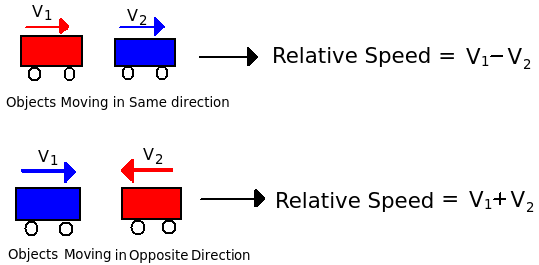Video on Problems on Trains - shortcuts, tips and tricksProblems on Trains
While studying the chapter “Trains”, we are required to deal with following scenarios: 1. Two trains moving in opposite direction.
2. Two trains moving in same direction.
3. A train crossing a stationary object of a given length like a platform or bridge.
4. A train crossing a stationary object like a pole or a man which can be considered as a point object.
Important Points to Remember1) If the
length of one train is P and the
length of second train is Q, the
total distance to be covered is
(P+Q)2) Finding Relative speed:

3) If two trains of lengths P and Q move in
opposite directions at V
1 m/s and V
2 m/s, then time taken by the trains to cross each other, can be calculated by
| Time Taken = | (P + Q) |
| (V1 + V2) |
4) If two trains of different lengths P and Q move in
same direction at V
1 m/s and V
2 m/s, then time taken by the trains to cross each other, is calculated by
| Time Taken = | (P + Q) |
| (V1 – V2) |
Quick Tips and Tricks 1) Time taken by a train of length L meter to pass a signal post or standing man = Time taken by the train to cover L meter.
A signal post or a standing man is considered to be the point object.
2) The time taken by a train of length L
1 meter to pass a
stationary object of length L
2 is basically the time taken by the train to cover (L
1 + L
2) meter.
3) The time taken by a train of length L
1 meter to pass a
moving object of length L
2 is determined by considering the relative speed between the moving objects.
Rs is the relative speed between moving objects in same or opposite direction.
L1 is the length of train.
L2 is the length of moving object other than train.
4) Two trains start from two points P and Q at the same time and move towards each other. These trains take p and q seconds to reach points Q and P respectively, the relation between them is given by
| (P's Speed) | = | q |
| (Q's Speed) | p |
Conversion of Units1) To convert km/hr into m/s
| km | = | 1000 m | = | 5 | m/s |
| hr | 60 x 60 sec | 18 |
Example: 50 km/hr = 50 x 5 /18 = 13.88 m/s
2) To convert m/s into km/hr
Example: 50 m/s = 50 x 18 / 5 = 180 km/hr
3) To convert minutes into seconds, multiply by 60
4) To convert hours into seconds, multiply by 60 x 60
The most important thing to remember in this chapter is to ensure the right usage of units and convert them wherever required. Question VarietyThere are 6 types of questions asked from this chapter.
Type 1 : I) A train crosses a stationary object on the platform. Find
a) the time taken or
b) length of train
A train of length 250 m runs at a speed of 70 km/hr. What will be the time taken to cross any stationary object standing at the railway station?
a. 20 sec
b. 17.23 sec
c. 12.86 sec
d. 9.5 sec
View solutionCorrect option: (c)
Given: Length of train = 250 m, speed of train = 70 km/hr
Length of train is always considered as distance, and hence here distance = 250 m
1) First convert speed of km/hr into m/s
| Speed of train = 70 x | 5 | = 19.44 m/s |
| 18 |
2) We know that,
| Time taken to cross stationary object = | 250 |
| 19.44 |
Time taken to cross stationary object= 12.86 sec A train takes 10 sec to pass a signal post and covers a distance of 10 km in 15 min. Find the length of train?
a. 100.1 m
b. 223.1 m
c. 111.1 m
d. 120.3 m
View solutionCorrect option (c)
We know,
| Speed = | 10 | x 60 = 40 x | 5 | m/sec = 11.1 m/sec |
| 15 | 18 |
Length of train = (Speed x Time)
= (11.11 x 10)
= 111.1 m